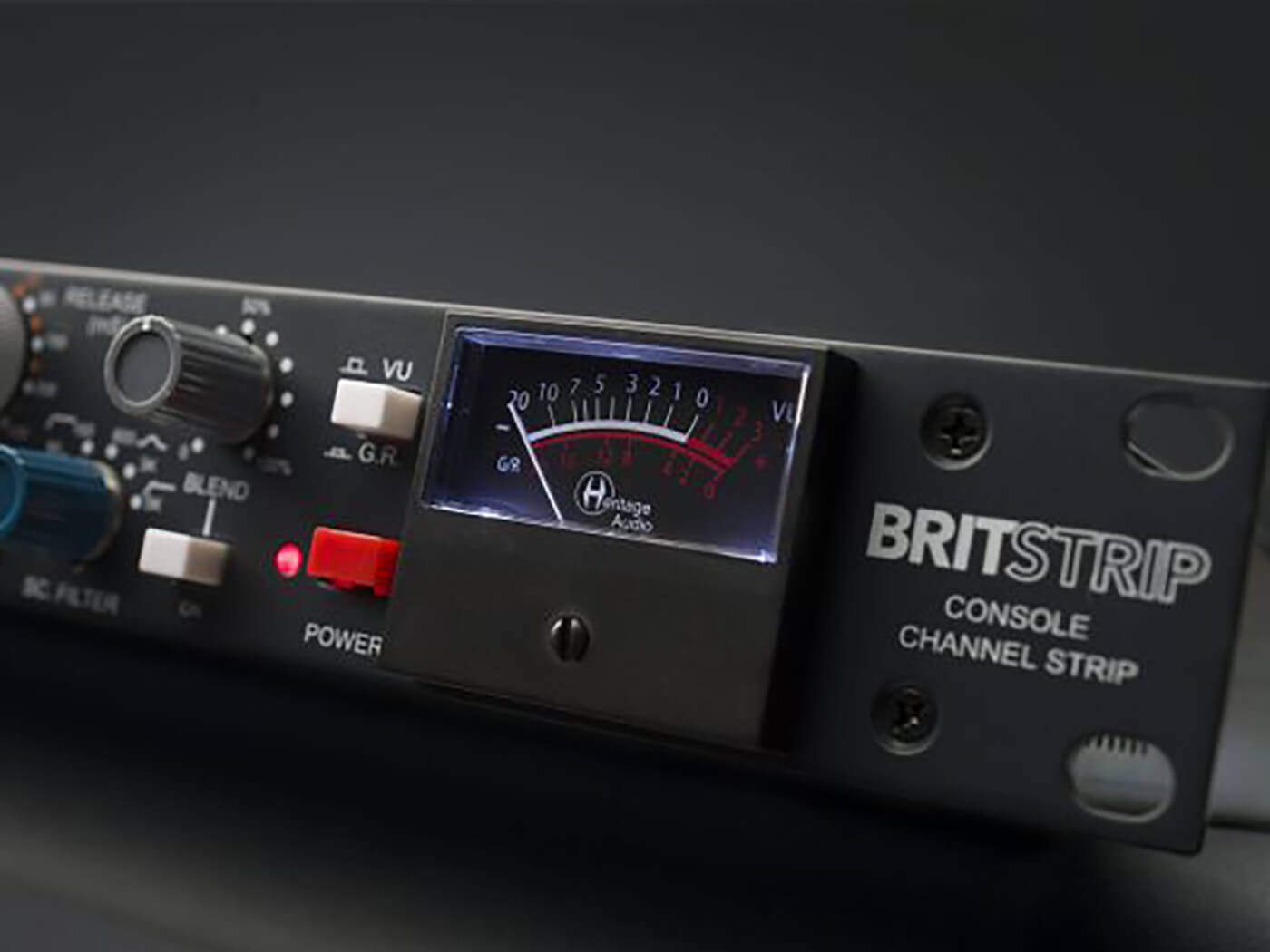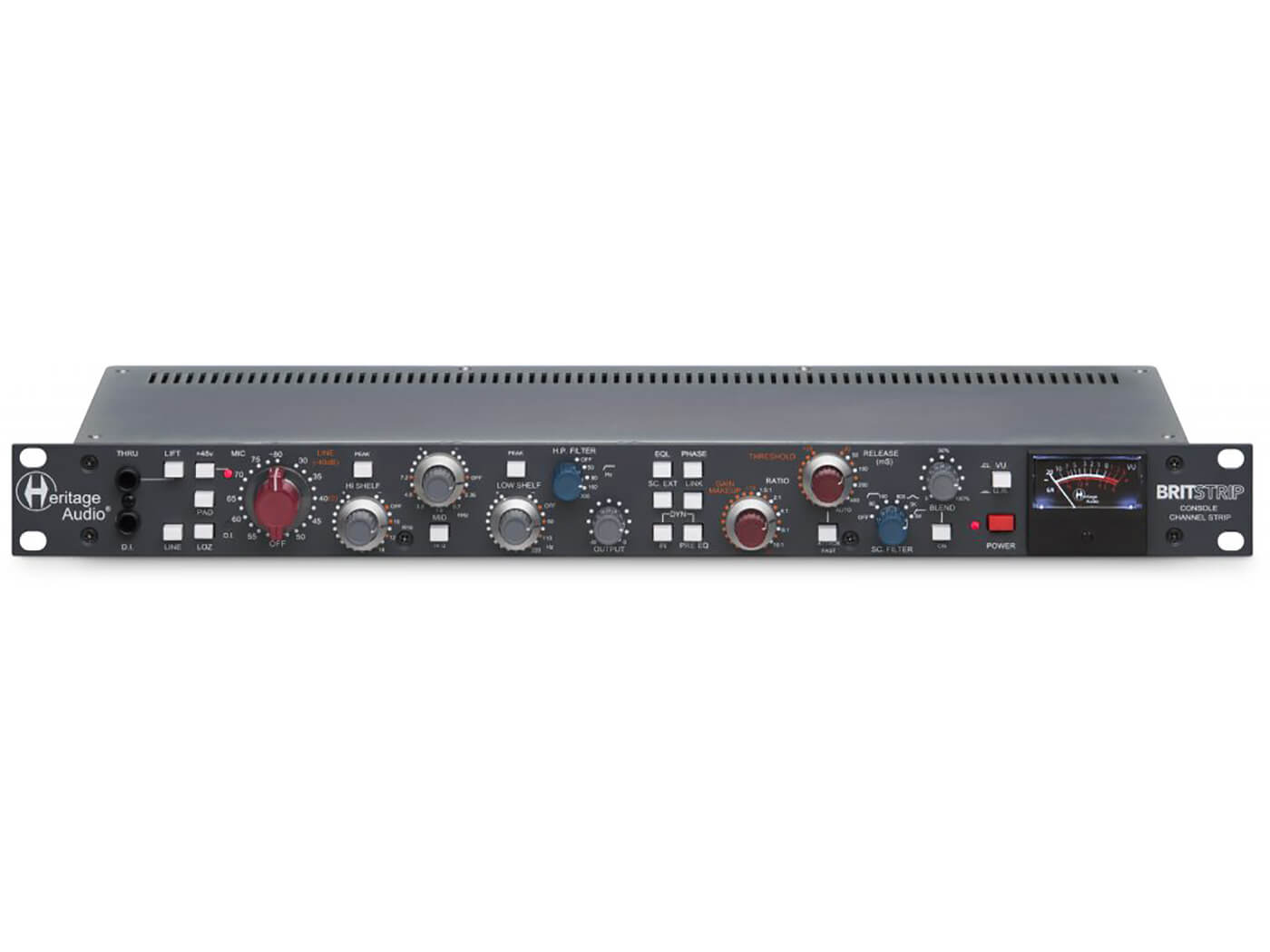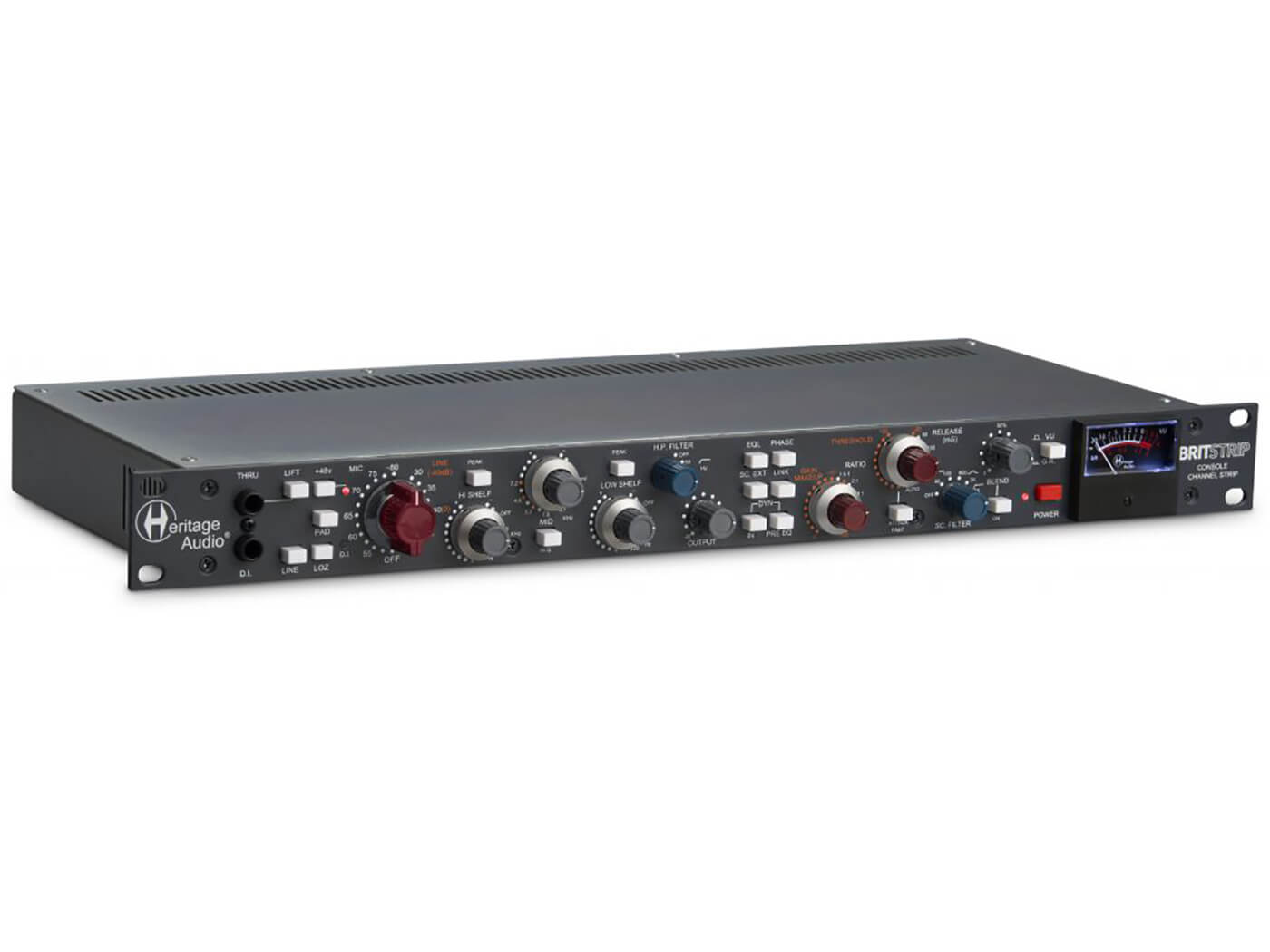Review: Heritage Audio Britstrip
Heritage Audio’s Britstrip is a console channel-strip love letter to Rupert Neve’s preamp and EQ designs, with a flexible compressor included for good measure.

Image: Heritage Audio
Review Overview
Our rating
9
Our verdict
⊕ Warm, generous EQ which musically shapes input sources
⊕ Flexible onboard compression with a ‘blend dial’ for parallel treatments
⊕ Also useful for line-level signals at the mix stage
⊖ More flexible compressor attack time would be welcome
⊖ Not cheap
If you’re drawn to the Neve preamp/EQ sound, the Britstrip is a strong alternative, with the added benefit of having a highly musical and versatile compressor.

Price £2262
Contact Heritage Audio
Heritage Audio is based in Madrid, but its latest product, a 1U rackmount channel strip, has its roots firmly planted in the UK. Based on the designs of the late, great Rupert Neve, the Britstrip combines a single-channel 1073-style mic preamplifier with EQ, supplementing the signal path with a diode bridge compressor. In short, it’s a front-end for recording vocals, guitars, drum channels and plenty more besides. However, it comes at a price that isn’t for the faint-hearted. So how does the Britstrip compare to its channel strip rivals?
Component heritage
The input stage starts with Heritage Audio’s 73JR mic preamp, whose custom input and output transformers are co-designed by Carnhill and manufactured in the UK. The headline figures are that the three-gain-stage design provides 80dB of gain with buttons for 20dB pad level attenuation, phase reversal and impedance control between 1200 or 300-ohm input sources. The latter provides the option to darken the tone of vintage dynamic or ribbon microphones. If you intend to use the Britstrip as a front-end for DI sources, input is via a quarter-inch socket on the front panel with a discrete, warm, JFET circuit before the preamp.
For simultaneous re-amping, you can route directly out to feed a separate amplifier channel via the Thru port. DI inputs are detected automatically when connected, with a green LED indicating this status. Otherwise, the Britstrip assumes a microphone input, with the option to toggle to line-level sources.
‘
Next comes a 3-band EQ, similarly based on a classic Neve 1073 design. At the outer limits are high and low shelf bands, separated by a dual Q mid-band, allowing you to make broad curve choices, or more surgical, narrower ones via a switch. High shelving is available at 10, 12 or 16kHz (with the option to switch shelving out for a peak curve instead), with low shelving options at 50, 80, 160 or 300Hz, at 18dB per octave. The mid-band range is wide, from 360Hz to 7.2kHz, notched at musically sensible steps to enable anything from subtle reinforcement of the middle of a snare drum to taming an over-zealous vocal rasp. Separately, a switchable high-pass filter allows roll-off at 50Hz, 80Hz, 160Hz and 300Hz.

Compressor flexibility
The EQ stage features its own output dial, in case you’d prefer to track without dynamics, a choice reinforced by the compressor section providing an ‘on’ button, letting you bypass this module easily.
The compressor is modelled on Heritage Audio’s own Successor, offering diode bridge style control over dynamics. It can be toggled to come before or after the EQ stage, thereby providing one-button experimentation over tone and dynamics.
The control options are what you’d expect. One concentric dial adjusts make-up gain and ratio (with options between 1.5:1 to 10:1), with the other controlling input threshold and release time. There is no dedicated control for attack time, but a button switches between the default speed and ‘fast attack’. The manual omits the specific timings for these options. Suffice to say that when tracking both vocals and drum sounds, the variable attack times make a significant difference, particularly when shaping percussive, transient-heavy sources.
The release times are perhaps more significant, as they’re broad enough (50mS to 400mS) to emulate FET or VCA-style compression behaviours, providing tremendous flexibility. The compressor features a flexible internal sidechain filter to omit frequency groups from compression detection, with high-pass options at 50Hz and 100Hz, mid-band peak filters at 800Hz and 3kHz and a further high-pass filter at 5kHz. There’s even greater flexibility available, too; you can create a send-and-return loop from the rear-panel connectors. One practical example of this allows you to use the compressor as a de-esser, for instance.
The compressor also features a blend dial to allow for parallel compression treatments. In addition to the blend dial, there’s an ‘on’ button, meaning that you can audition a parallel compression treatment immediately, rather than having to turn the dial up and down. This is a thoughtfully designed addition.
Rule brit-annia
The Britstrip is a joy to work with. The preamp sounds sumptuous and while this isn’t a Neve in name, it draws accurately from the legacy of the 1073 design. The sound is open and warm, with sources becoming more musical as the Britstrip works its magic. The EQ is wonderful; engineers and producers tend to be cautious at the tracking stage, knowing how easy it is to compromise recordings with over-bold tone and dynamics choices. But the EQ section here really does allow for configuration of tone in a way that rewards experimentation. The mid-band, in particular, doesn’t become harsh, even with generous boosts; its curves seem to wrap around microphone and line signals without trying too hard to fundamentally change their personality.
However, the compressor is the ace-in-the-hole. In-the-box parallel treatments and flexible, generous side-chain options mean that you can significantly tailor the dynamic response of source sounds to the needs of your production. And, if you’re concerned about over-compressing at the tracking stage, routing a recorded signal back through the Britstrip at the mix stage allows you to benefit from more tailored settings on a second pass. Accordingly, this channel strip oozes class. It assumes you have a great microphone, a fantastic performer and a professional recording space and it’s ready to ensure that all of that wonderful sonic potential is captured, enhanced and gently elevated to form the backbone of great tracks and productions.
Of course, such quality comes at a price and the Britstrip is, for most people, a premium option. However, the asking price puts the Britstrip in the same ballpark as alternative channel strip options, including some from AMS Neve and Rupert Neve Designs. Crucially, though, the Britstrip punches at its weight in class and sound quality. Perhaps this is the most concise way to summarise my thoughts: I want one.
If you need a high-quality tracking control strip, then Neve’s designs should certainly also be among the options you check out – the closest for price and features is the AMS Neve 8801 Channel Strip.
The legacy of the great man’s attention to detail and rich, warm, classic sound is in full evidence from the start of the Britstrip’s signal flow to the end. Flexibility and sound quality put Heritage Audio Britstrip towards the top of the charts in this price range. If you’re drawn to Neve’s preamp and EQ designs, the Britstrip is that in all but name, with the added benefit of a highly musical dynamics processor, too.

Key Features
- Carnhill-based transformer-coupled inputs and outputs
- Microphone, line-level and instrument input
- 80dB maximum gain
- 3-band EQ, high and low shelving bands have switchable bell response
- Inductor-based switchable high-pass-filter
- Diode bridge compressor mimics FET and VCA response
- Flexible internal and external sidechain system
- Re-amping of DI sources is possible via Thru
- VU metering shows output level or gain reduction
- Stepped controls for easy recall